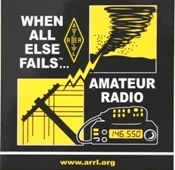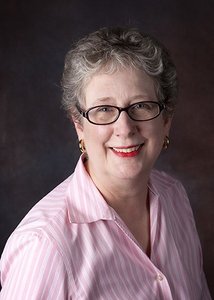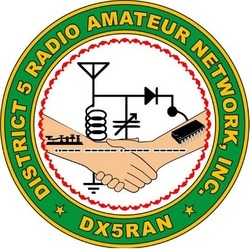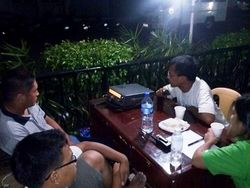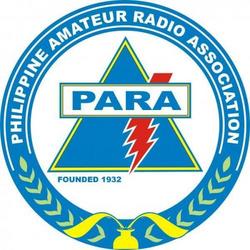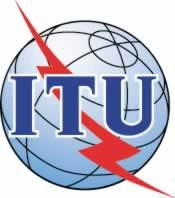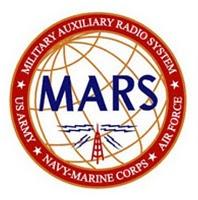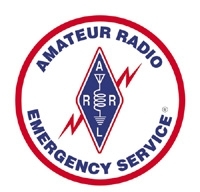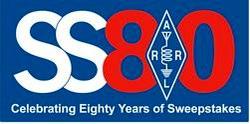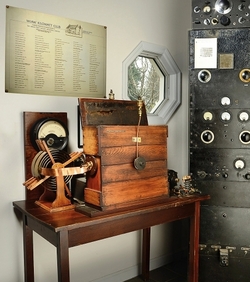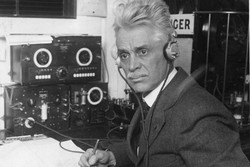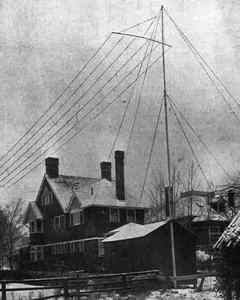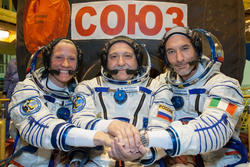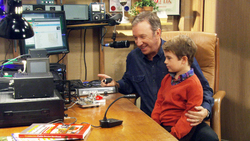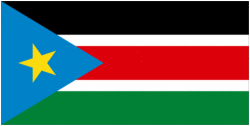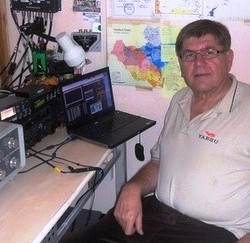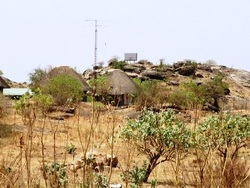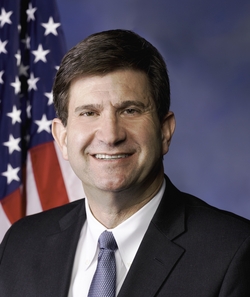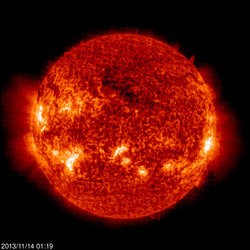 November 14, 2013 John E. Ross, KD8IDJ, Editor
| |||||||||||||||||||||||
Public Service: Philippine Amateur Radio Volunteers Fill Communication Gap
In the devastating aftermath of what some weather experts are calling the most severe typhoon (hurricane) ever, Philippine Amateur Radio volunteers are providing communication support for governmental and relief agencies as rescue and recovery operations are underway. In many cases, ham radio is the only communication available, as Typhoon Haiyan ("Yolanda" in the Philippines) took out the telecommunication infrastructure as well as electrical power over a wide area. "No words to describe what my beloved Philippines is going through," Thelma Pascua, DU1IVT, posted to her Facebook page.
Hardest hit was the city of Tacloban, the capital of Leyte province. The death toll still has not been determined, but at least 2500 lost their lives, and 600,000 or more were left homeless -- some largely without food and water -- awaiting the arrival of outside assistance. Ramon Anquilan, DU1UGZ, of the Philippine Amateur Radio Association (PARA), said that amid the chaos, Ham Emergency Radio Operations (HERO) stations on HF and VHF have been aiding authorities and residents throughout the archipelago. He reported that some of the pressure has been lifted, now that some cellular telephone and Internet service has been restored in Tacloban. The HERO station there has been handling health-and-welfare inquiries. Ironically a curfew imposed to maintain law and order has prevented the station from staying on the air after dark. "It appears that the NTC [National Telecommunications Commission] had an emergency meeting and decided to provide hams in the area with mobile rigs and hand-held portables," he said. "The NTC's awareness of the importance of Amateur Radio is maturing, and there are talks of our clubs training and maintaining stations NTC regional offices." Anquilan said national and emergency response agencies have relocated the command post to the Tacloban Grandstand, while the HERO District 5 Radio Amateur Network (RADNET) station, using the call sign DU5AOK, remains on the second floor of city hall in Tacloban -- with security, food, and logistics problems now cropping up.
"We are urgently requesting assistance to sustain the DU5AOK station and ensure operations in the other hard-struck areas are established -- Samar, Panay, Cebu, Biliran, and the tourist area of Palawan," he said. The local government has been maintaining the emergency generator powering the station. Anquilan specifically mentioned a need for field-deployable systems, power generators, antenna systems, food or ration packs, and tents for the operators. Anquilan said the NTC has employed the HERO network to handle several messages. He said the Red Cross used the Tacloban HERO station to track a relief vehicle to verify the welfare of its volunteers, who had been stopped and ransacked by storm victims impatient for aid to arrive. As a matter of policy, the Tacloban station and others in the disaster areas were accepting only outbound traffic as priority messages, Anquilan explained. These include health-and-welfare traffic, messages from institutions and government agencies to Manila, and urgent requests for specific assistance or relief. He estimated that HERO operations will remain active for at least another week. "As the primary telecom services are restored, there will be less reliance on the Amateur Radio service in Tacloban," Anquilan said. "This will mean a more difficult period, because the remote areas not reached yet by government and other agencies will now demand communication links." He predicted that ham radio assets will be spread thinly, resulting in gaps.
Elsewhere, the Cebuano Amateur Radio League (CARL) has established an HF station in Bantayan, at the northern tip of Cebu. The municipality was the hardest hit in Cebu, with an estimated 90 percent of structures leveled by the storm. The Chocolate Hills Amateur Radio League (CHARL) club station DX7BC and members are standing by to monitor and relay messages between Tacloban and the principal receiving stations. Stations scattered throughout the Philippine archipelago are receiving outgoing traffic from Tacloban and the other affected areas. Additional operators are on standby to relay traffic as necessary.
Anquilan said the news media have begun noticing ham radio but fail to understand the important role the HERO network has been playing in the wake of the disaster. "Although there's some very brief TV exposure, they are yet to adequately report on the voluntary service it provides, and the emergency communications to the agencies and community in times of disaster," he said. Milt Camp, K6OYX/DU2OYX -- founder of Los Médicos Voladores (The Flying Doctors) -- lives in the Philippines (Baguio City in Luzon) and has been assisting with emergency communication. He reported that ham radio volunteers there are using HF to handle outbound traffic on 14.277 MHz. "We had a lot of wind even in this area 400 kilometers north of the typhoon," he reported. "I did take down my antenna for the [worst] of the wind but put back as soon as I could." He said a net on 7.095 MHz "has been on 24/7" since the typhoon. Camp said he believed the international net on 14.277 MHz was being used to contact families in areas hit by the typhoon. "We do have medical people from this area going to the damaged area starting this weekend," he added. ITU Deploys Satellite Communications The International Telecommunication Union (ITU) announced this week that it had deployed satellite communication equipment to the Philippines to help re-establish "communications vital for search and rescue" in areas severely affected by Typhoon Haiyan (Yolanda). Amateur Radio volunteers throughout the Philippine archipelago have been a primary communication link since the storm struck November 8, and their efforts continue.
"ITU is prepared to help the government and people of the Philippines in every way possible in their hour of need, and to deal with the colossal tragedy that has overwhelmed the country with unimaginable loss of life and property," ITU Secretary-General Dr Hamadoun I. Touré, HB9EHT, said. Noting that it "could be weeks or months" before the telecommunication infrastructure is back in order, the ITU -- a specialized UN agency -- said it hoped the equipment would help in assessing the widespread damage and loss of life as well as "enable much-needed support for search-and-rescue services as well as the need for families to re-establish contacts." The equipment can be charged from automotive batteries and has solar panels for back-up power, the ITU said. The ITU also has sent communication experts to the Philippines to train first responders in the use of the equipment during search-and-rescue operations and for logistical support. -- Thanks to Jim Linton VK3PC, Carl Croci, NI6Z, Milt Camp, DU2OYX, and the ITU Public Service: MARS Operators Complete "Exemplary" Simulated Disaster Response Exercise Radio amateurs in the Military Auxiliary Radio System (MARS) concluded an unprecedented 48-hour marathon exercise November 5 that linked the continental US, Hawaii, Japan, Europe, and Canada during a simulated breakdown of normal communication systems, including the Internet. For the first time in a nationwide test, W1AW staffers activated the Maxim Memorial Station Army MARS station AAN1ARL at ARRL Headquarters to facilitate input from the Radio Amateur Civil Emergency Service (RACES) community.
"Well done by all," messaged Army MARS Chief Stephen Klinefelter, when the test was concluded. The exercise involved the transmission of hundreds of encrypted messages via HF radio. The traffic carried "situational awareness" information needed by a joint Department of Defense entity responsible for responding to a national crisis situation. Many operators, net control and relay station members in particular, put in long hours maintaining the seamless connection. Joining Army MARS in providing backup communication for the US Department of Defense entity were members of the Navy-Marine Corps and Air Force MARS branches. Elements of the National Guard, FEMA, the Transportation Security Administration, and selected state authorities also participated. During the final day of the exercise, MARS members also acted on a real-world request from DoD to be prepared to monitor International Amateur Radio Union (IARU) emergency frequencies as Typhoon Haiyan appeared poised to develop into a category 5 storm and strike the Philippines. MARS members were given strict time limits for providing the requested information in order to receive credit for completing their message handling. These statistics will be used to evaluate how quickly and efficiently the multi-branched network might be able to handle information requests and responses under conditions mirroring an actual catastrophe. Poor propagation, particularly in the overnight hours, added a realistic touch. A formal after-action report from Army MARS Program Officer Paul English, WD8DBY, and Operations Chief David McGinnis, K7UXO, in still in the works, but Klinefelter saluted the overall performance. "You have just completed the most complex and longest MARS communications exercise in recent history," he said. "I want to thank each of you for participating and devoting long hours to make this exercise a success. The dedicated efforts to maintain effective nationwide contingency communications support demonstrated by all participants were exemplary."
Discussions between ARRL Headquarters staff, US Army MARS Region 1 leadership, and English preceded the exercise. Eastern Massachusetts was chosen for the first test of full-scale collaboration between ARES and MARS, and Tim Wortley, KQ1Y, the MARS state director for Southern New England, worked out the details with Eastern Massachusetts Section Emergency Coordinator Rob Macedo, KD1CY. Wortley said he received more than a half-dozen responses to inquiries he'd put into the system. Other tactical voice messages on amateur VHF repeaters were forwarded to MARS circuits. The ARES test was separate from the activation of the MARS station at W1AW. On the Air: ARRL November Sweepstakes Marks 80 Years -- Redux! This weekend, the 2013 ARRL November Sweepstakes phone event will dominate the bands, continuing the 80th running of the oldest domestic ham radio contest. Sweepstakes -- also known as "Sweeps" and "SS" -- debuted in 1930, but ham radio was suspended during World War II. The action gets underway at 2100 UTC Saturday and runs through 0259 UTC Monday. The 2013 ARRL November Sweepstakes Operating Guide provides details. An ARRL November Sweepstakes webinar by ARRL Contest Branch Manager Mike DeChristopher, N1TA, has been posted to the World Wide Radio Operators Foundation website.
An eHam article, "An Enticement for Contest Newbies" by Sweepstakes Manager Larry Hammel, K5OT; Ward Silver, NØAX, and Mike Gilmer, N2MG, helps explain the intricacies of SS and offers valuable tips to newcomers. The somewhat lengthy SS exchange, which participants must copy accurately to earn points, reflects the event's origins as a traffic-handling exercise and borrows some radiogram vocabulary. It consists of a consecutive serial number (leading zeroes are not required); a "precedence" -- a letter representing your entry category, eg "A" for single ops running 100 W; your call sign; a "check" consisting of the last two numerals of the year in which you were first licensed, and your ARRL or Radio Amateurs of Canada Section. Participants work each station once for contact points, and the score multiplier is the number of ARRL/RAC sections worked (83 total). As noted in advance of the CW weekend, the number 80 comes into play for participants in this weekend's contest who want to enhance the fun and the challenge by setting some individual achievement goals this year -- for example, for working 80 contacts per mode, scoring 80,000 points (total), running 80 W, and even for working all ARRL sections traversed by Interstate 80 and all sections on 80° W longitude. SS operators also can earn recognition for working all of the ARRL Sections in place in 1930 -- there were 68 back then, as opposed to 83 today. New this year are an 80 years T shirt and "Clean Sweep" coffee mug, as well as participation pins and a special certificate. Operators 80 years old or older and all participating clubs will get special recognition. Details are on the ARRL November Sweepstakes web page. On the Air: Rare, Brief 6 Meter F2 Opening Makes for Plentiful DX Six meter operators were treated November 9 to an F2 opening from approximately 1500 until 1630 UTC. "These have been very rare in Solar Cycle 24," said QST "The World Above 50 MHz" Editor Jon Jones, NØJK. He described the opening as "mostly single-hop F2" from the East Coast, Midwest, Gulf Coast, and to the West Coast to Central America, Northern South America and Caribbean. Jones said the geomagnetic field was active, with a K of 4, due to what Spaceweather.com called "a gusty stream of solar wind buffeting Earth's magnetic field, sparking auroras around both of our planet's poles." Jones said he was "late to the show" because he'd worked the night before. He didn't get into the fray until 1550 UTC after he saw all the 6 meter spots showing up. "I turned on the radio, and FM5AN, P43A, PJ4NX, etc were all blasting in loud here in eastern Kansas," he said. "I worked FM5AN and P43A from home using a M2 loop in the attic. Jean, P43A said I was S-9. Nothing new or rare, but any F2 on 6 meters in solar cycle 24 is a treat." Your League: Nominations Due December 31 for 2013 ARRL International Humanitarian Award Nominations are due December 31 for the 2013 ARRL International Humanitarian Award. This award is conferred upon a radio amateur or amateurs who demonstrate devotion to human welfare, peace and international understanding through Amateur Radio. The League established the annual prize to recognize Amateur Radio operators who have used ham radio to provide extraordinary service to others in times of crisis or disaster. A committee appointed by the League president is now accepting nominations from Amateur Radio, governmental or other organizations that have benefited from extraordinary service rendered by an Amateur Radio operator or group. Amateur Radio is one of the few telecommunication services that allow people throughout the world from all walks of life to meet and talk with each other, thereby spreading goodwill across political boundaries.
The ARRL International Humanitarian Award recognizes Amateur Radio's unique role in international communication and the assistance amateurs regularly provide to people in need. Nominations should include a summary of the nominee's actions that qualify the individual (or individuals) for this award, plus verifying statements from at least two people having first-hand knowledge of the events warranting the nomination. These statements may be from an official of a group (for example, the American Red Cross, The Salvation Army, a local or state emergency management official) that benefited from the nominee's particular Amateur Radio contribution. Nominations should include the names and addresses of all references. All nominations and supporting materials for the 2013 ARRL International Humanitarian Award must be submitted in writing in English to ARRL International Humanitarian Award, 225 Main St, Newington, CT 06111 USA. The winner of the ARRL International Humanitarian Award receives an engraved plaque and a profile in QST and other ARRL venues. Your League: HPM's "Old Betsy" is Returned to Operating Order
Back in the day -- prior to 1989, to be more specific -- ARRL tours were treated to a demonstration of League Co-Founder Hiram Percy Maxim's rotary spark-gap transmitter, "Old Betsy." The vintage transmitter, on display in the lobby of the Maxim Memorial Station W1AW, sustained some damage, however, and she has remained silent for nearly 24 years. Until now. "It's always been my intention to get Old Betsy working again," W1AW Station Manager Joe Carcia, NJ1Q, explained. "Seeing that next year is our Centennial, I made her functionality one of my priorities." For Amateur Radio newcomers, a spark-gap transmitter is pretty much as it sounds. A very high voltage is applied to two electrodes sufficient to cause the electrons to bridge -- or spark across -- the gap between them. Various circuits, and the antenna, are used to tune this broad-
spectrum energy -- essentially a radio signal (think power line noise or interference from a vacuum cleaner) -- to a particular radio wavelength. An improvement on this basic concept was the rotary spark-gap transmitter, where a motor rapidly turns a number of electrodes (Old Betsy has four) past stationary electrodes. This helps to generate a semblance of a "note" on the Morse transmissions in that era before receivers had circuitry to make CW sound as it does today. Old Betsy is considered a non-synchronous rotary spark gap, Carcia points out, and the belt-driven rotor spins at approximately 2500 RPM. The rotating and stationary electrodes are housed within a handcrafted wooden box with an open top.
In the olden days of Amateur Radio -- the 1920s -- Maxim, known as "HPM," had Old Betsy installed in the basement of his Hartford, Connecticut, home and keyed it from his operating position on the first floor above. A spark-gap transmitter can generate a lot of noise -- both ambient and throughout the radio spectrum -- so keeping "Old Betsy" and the operator on separate floors made good sense. The transmitter is equipped with an RF ammeter to measure the RF current flowing into the antenna, although one is no longer connected. Carcia says Betsy once again is ready for prime time. "I've repaired Old Betsy -- and placed a protective polycarbonate shield around her as well," he says. "Old Betsy is now functional." But it will only be run without an antenna. The FCC banned spark transmitters in the 1930s. Read more. Ham Radio in Space: Two Hams, One Olympic Torch Return Home from ISS Two astronauts and a cosmonaut returned safely to Earth from International Space Station November 11. The Expedition 37 crew of European Space Agency Astronaut Luca Parmitano, KF5KDP; Russian ISS Crew Commander Fyodor Yurchikhin, RN3FI, and NASA astronaut Karen Nyberg landed in a Soyuz spacecraft in the Kazakhstan steppe, returning in the same spacecraft that took them to the ISS last May.
They carried with them the Olympic torch that went into space recently with the Expedition 38 crew. Richard Mastracchio, KC5ZTE, Russia's Mikhail Tyurin, RZ3FT, and Japan's Koichi Wakata, KC5ZTA, arrived at the International Space Station November 7, carrying the torch, which will be used to light the Olympic flame in Sochi, Russia, for the 2014 Winter Games. Parmitano spent five months on the ISS for his "Volare" ("I will fly") mission, under a bilateral agreement with Italy's space agency and NASA. While in space, he proved to be an enthusiastic and passionate radio amateur and handled several Amateur Radio on the International Space Station (ARISS) school contacts. "When all questions prepared by the students could not be answered during the scheduled pass, Luca used to come back whenever possible to continue the space talk on the following orbit," reported ARISS-Europe Chairman Gaston Bertels, ON4WF. Parmitano ranks fourth in terms of the number of ARISS school contacts performed during a single expedition. As IRØISS, Parmitano also made more than 230 random contacts with hams on Earth. -- Thanks to Gaston Bertels, ON4WF Ham Radio in the Media: TV Show Featuring Fictional Ham Sparks Crop of Real Hams
Fans of the ABC Television show "Last Man Standing" may be aware that its main character, "Mike Baxter" -- played by Tim Allen -- is supposed to be a radio amateur, KAØXTT. While it may come as no surprise that the sitcom's producer is a ham -- John Amodeo, NN6JA -- several radio amateurs also are on the production crew, and their number just increased, with help from the Greater Los Angeles Amateur Radio Group (GLAARG) VEC. The show's "Thanksgiving" episode, which airs Friday, November 22 (8 PM ET), will feature a scene with "Baxter" in his basement ham shack. Amodeo said that for the first time in the series, Baxter will briefly talk on the radio. In response, viewers will hear a pileup created by using the voices of hundreds of real hams, sent in to the production company. In the scene, the Mike Baxter character appears with his grandson "Boyd," played by Flynn Morrison. The episode was shot in mid-October. According to Amodeo, Mike heads to his basement ham shack to escape a houseful of guests waiting for Thanksgiving dinner to be served. This episode of the show is only the second to include ham radio as a story element and the first in which Tim Allen's character is shown operating his ham station.
At an exam session on November 9, the "Last Man Standing" crew added eight new Technician class hams to its crew as well as its first General upgrade. GLAARG volunteer examiners Norm Goodkin, K6YXH; Naomi Goodkin, WB6OHW, and Rob Antonacci, AA6RA, administered the test session. Including the additional new hams, the show's behind-the-scenes crew complement now boasts 14 Technician, one General, and two Amateur Extra class operators. In "Last Man Standing," Allen's character Mike, a pickup-driving sporting goods marketing manager, must spend more time in his female-dominated household after his wife gets a promotion at work. The couple's three daughters are not prepared for the shift to his stricter parenting style. DX: South Sudan Z81X Operators Encourage DX University's "Best Practices"
The multinational group activating Z81X from South Sudan November 15-28 will emphasize 160 and 80 meters. It also is urging DXers to be on their best behavior in the anticipated pileups. The DXpedition period includes the CQ World Wide DX CW contest, when Z81X will have as many as three single-band stations active; there will be a non-contest, low-band SSB focus during the contest weekend as well. The Z81X team departed November 13 and was scheduled to team up with Z81B and Z81D to set up their low-band antennas and start a series of workshops for the government of South Sudan. "At least one station should be operational by late Friday evening," the team announced this week. "Their selected low-band operating frequencies are 1826.5 KHz and 3523 KHz." The Z81X expedition will not announce its operating frequencies on other bands in advance and advises checking Internet spotting networks.
The Z81X operators also will know if you've been bad or good. They will be looking for conduct that is consistent -- or inconsistent -- with the DX University "Best Practices for Courteous and Efficient DXing." The DXpedition ops plan to record many segments of the operation in stereo -- with Z81X on one channel and the DX pileup on the other -- then upload selections to the DX University website to illustrate certain points. Hosted by the South Sudan Ministry of Posts and Telecommunications, the group, led by IARU Region 1President Hans Blondeel Timmerman, PB2T, also will conduct a series of workshops, with support by the Yasme Foundation, aimed at establishing a sound Amateur Radio spectrum management and regulatory regime for the Republic of South Sudan. Other operators will include Dietmar, DL3DXX; Wayne, N7NG; Olli, OHØXX; Martti, OH2BH; Pertti, OH2PM; Veijo, OH6KN, and Tevfik, TA1HZ (the team doctor), plus Massimo, Z81B (IZØEGB), and Diya, Z81D (YI1DZ). Plans call for three generator-powered stations with amplifiers, low-band verticals and Beverage antennas; two sites may be used. Z81X team members will use their QRZ.com page to provide updates and to recognize supporters. Team updates also will appear on the DX University website.
Toward the end of the Z81X effort, the operators will try a modern twist on an old method to work as many of the "more-deserving, but DX-challenged" DXers as possible. Details will be announced. Z81X Project Goodwill South Sudan is organized jointly by Radio Arcala, DX University, IARU Region 1, and Rock City Investments Co; the equipment sponsor is Yaesu. The group welcomes support from individuals, clubs and foundations. Visit the Z81X QRZ.com page. QSL via OHØXX. The ARRL DXCC Desk has approved the Z81X operation earlier this year for DXCC credit. -- Thanks to Jarmo Jaakola, OH2BN DX: Third 2013 Myanmar Operation Set Zorro, JH1AJT, and others will be on air from Myanmar (formerly known as Burma) from November 15 until November 26. The proposed call sign is XZ1J. According to The Daily DX, this will be the third and final run for 2013 from Myanmar. Plans call for setting up and running up to four stations 24/7 on 160 through 10 meters, CW, SSB and RTTY. -- The Daily DX; Jay Oka, JA1TRC DX: Illinois Congressman Chats with K9W Team on Wake Island
US Representative Brad Schneider (IL-10) isn't even a ham, but he got to work one of the most popular DXpeditions now on the air. The congressman spoke with K9W op Jerry Rosalius, WB9Z, on Wake Island from the Northbrook station of Wally Klinger, W9BEA -- a member of the Northern Illinois DX Association. The two met about a week ago in Schneider's office, where Klinger had gone to express concerns regarding access to certain US islands to carry out DXpeditions. The Wake Island team ran into difficulties when the partial US government shutdown occurred just as the K9W team was supposed to fly on a US Air Force aircraft to Wake. Klinger invited the first-term congressman to visit his station to speak with the radio amateurs at
K9W. According to Klinger, Schneider "is aware of the issues that we have getting on US incorporated territories such as Navassa, Johnston, etc." After Klinger made contact with K9W on 15 meters, Schneider took the mic and spoke with Rosalius "just like a pro," Klinger said. Afterward, Klinger displayed his QSL card collection, pointing out how the number of DXpeditions from US island territories such as Wake had dropped significantly over the past several years. As the congressman departed, Klinger gave him several recent copies of QST that highlighted DXing, Field Day and public service work. The ARRL DXCC Desk has approved the 2013 operation of K9W -- Wake Island -- for DX Century Club credit. -- The Daily DX The K7RA Solar Update
Tad "Seasons in the Sunspots" Cook, K7RA, reports from Seattle, Washington: Solar activity remains relatively robust. Average daily sunspot numbers over the past week declined from 131.7 to 126.1, fewer than six points. A few "off days," November 9-11 contributed to the decline, but sunspot activity during the week otherwise was strong, beginning at 159 and 160 on November 7-8. Solar flux was up nearly 11 points, rising from an average of 146 on October 31-November 6 to 156.9 in the recent period, November 7-13. The latest prediction shows solar flux at 170 and 165 on November 14-15, 160 on November 16-20, 150 on November 21-22, 145, 140 and 135 on November 23-25, 130 on November 26-27, 135 on November 28, 140 on November 29-30, 135 on December 1-3, 130 on December 4, and 135 on December 5-6. Predicted planetary A index is 5 on November 14-15, 10 on November 16-17, 5 on November 18 through December 3, 8 on December 4, and 5 on December 5. In Friday's bulletin expect an updated forecast for the phone weekend of the ARRL November Sweepstakes, plus comments from readers. Just Ahead in Radiosport
Upcoming ARRL Section, State and Division Conventions and Events
Find conventions and hamfests in your area. ARRL -- Your One-Stop Resource for Amateur Radio News and Information Join or Renew Today! ARRL membership includes QST, Amateur Radio's most popular and informative journal, delivered to your mailbox each month. Listen to ARRL Audio News, available every Friday. Subscribe to... NCJ -- National Contest Journal. Published bi-monthly, features articles by top contesters, letters, hints, statistics, scores, NA Sprint and QSO Parties. QEX -- A Forum for Communications Experimenters. Published bi-monthly, features technical articles, construction projects, columns and other items of interest to radio amateurs and communications professionals. Free of charge to ARRL members: Subscribe to the ARES E-Letter (monthly public service and emergency communications news), the ARRL Contest Update (bi-weekly contest newsletter), Division and Section news alerts -- and much more!
| |||||||||||||||||||||||
